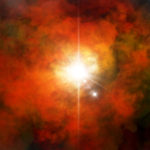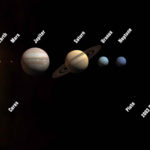114 Billion Years Ago
Formation of the Universe
The universe is created in the Big Bang. At this time basic building blocks are created. These basic blocks include electrons, quarks, protons, and neutrons.
2300,000 Years After the Big Bang
First Atoms
The universe continues to expand. At the same time, the universe cools. This results in some of the basic building blocks coming together and creating atoms. Hydrogen and helium are the first atoms created from the building blocks.
313 Billion Years Ago
First Galaxies
The force of gravity begins to attract the hydrogen and helium gas into clumps. Eventually, these clumps begin to form stars. In turn, galaxies are created from these stars. Stars begin to create new elements such as oxygen and iron.

410 – 11 Billion Years Ago
Formation of the Milky Way Galaxy
The Milky Way galaxy is created. Our solar system is located within the Milky Way.
54.5 Billion Years Ago
Formation of the Solar System
The solar system is created from gas and dust particles. These particles condense and create the sun. Close to the sun, small rocky planets are formed from heavy materials. Further away from the sun, giant planets are created from ice particles.
Formation of the Earth and Moon
The Earth and other planets are formed. The Earth collides with a planet the size of Mars. After the collision, the Earth begins to develop its layered structure. The layers are the crust, mantle and core. At the same time, loose particles around the Earth are slowly pulled together by gravity. Eventually, these particles create the moon. This is also a period of constant meteorite bombardment for the Earth and moon.
63.8 Billion Years Ago
Formation of Oceans, Atmosphere, and Single Cell Life
The atmosphere and oceans are formed in the outermost layer of the Earth. Slowly, the atmosphere and oceans begin to evolve. Early single-celled plants emerge and begin to alter the atmosphere. Through photosynthesis, these plants increase oxygen levels in the atmosphere. In turn, the oxygen creates a protective ozone layer that reduces ultraviolet radiation reaching the Earth’s surface.
72.8 Billion Years Ago
Rise in Atmosphere’s Oxygen
Single celled organisms continue to produce oxygen. At first, the oxygen is chemically combined with rocks. However at some point in time, the oxygen content of the atmosphere begins to increase significantly
82.2 Billion Years Ago
Multicellular Marine Organisms Appear
Small multicellular (many cells) begin to appear in the oceans.
9600 Million Years Ago
Large Marine Animals Appear
Large animals begin to appear in the oceans.
10500 Million Years Ago
First Terrestrial Plants
Plants begin to appear on land. These plants are mostly mosses.
11425 Million Years Ago
First Terrestrial Animals
Small arthropods begin to appear on land. A the same time, vascular plants that grow upright begin to appear.
12365 Million Years Ago
Tetrapods and Forests
The first tetrapods appear. A tetrapod is a four legged animal. The first tetrapods are amphibians. Vascular plants begin to spread and forests begin to cover the land.
13230 Million Years Ago
First Dinosaurs
Dinosaurs appear on land. Reptiles become the dominant life on land.
14210 Million Years Ago
First Mammals
Small primitive mammals begin to appear on land.
1565 Million Years Ago
KT Extinction Event
The Earth is hit by a large meteorite. This triggers an extinction event. Over half of the life on Earth becomes extinct. Dinosaurs become extinct and this marks the rise of the mammals.
16300 Thousand Years Ago
Early Homo sapiens
Modern humans appear in Africa. This marks the beginning of an era dominated by humans.


